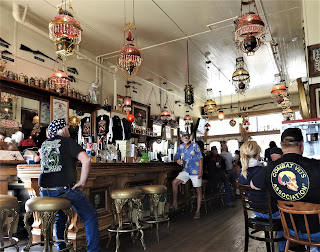Nobody knows why this town
got the name, “Fernley.” In fact, it all
began in 1902 when a few farmers got together and thought this would be a good
place to grow some crops because of an irrigation project on the Truckee
River. So they were all happily growing
their beans and corn and then the railroad showed up. By this time, the community had decided to
call itself, “Fernley,” and the railroad decided it was a good place for a
siding. In 1908, they got a Post Office
and by 1910, Fernley had 159 belly buttons.
The rest is history. Now, there
are about 20,000 Fernleyans. This is the
Reader’s Digest version. (And yes, they
have a Walmart.)
 |
| What's left of Fort Churchill |
 |
| Hospital at Fort Churchill |
 |
| Officers' quarters |
A bit south of Fernley, Fort
Churchill was established in 1860, with the usual goal of protecting settlers
and travelers against Indian aggression.
Capt. Joseph Stewart was in charge of building the fort and being no
dummy he named it for his boss,
Sylvester Churchill, Inspector General of the Army. Their job also included protecting the
overland routes of the Pony Express.
The Fort was intended to
be a permanent installation and was built on stone foundations and structures
made of adobe. It was ¼ mile square,
buildings all around the sides with a big center courtyard. The buildings included barracks, six
officers’ quarters and a hospital. Plans
change. In 1869, the military had
decided the job was finished and the fort was abandoned. Enter Samuel Buckland, who bought the whole
shootin’ match for $750 US.
 |
"We're going out there and then
up and over those mountains, right?
Ummm.... why?!" |
 |
| Buckland Station |
Sam Buckland was an entrepreneur,
farmer and rancher. He supplied the
military, the emigrants and the local community with food, supplies and
horses. He established Buckland Station,
a Pony Express stop where the riders were supplied with fresh mounts to
continue their ride. Sam, the new owner
of the abandoned fort, stripped it of structural materials and used some of
them to build Buckland Station where he and his wife, Eliza, lived. Sam, Eliza and 5 of their 8 children (ages 8,
2, 1, 2 days and “infant no dates”) are buried at Fort Churchill and are the only
remaining graves. The 44 servicemen’s
graves have been moved to a military cemetery in Carson City.
 |
| Pony Bob |
 |
| The Buckland family gravesites |
One of the more famous
Pony Express riders was Robert Haslam.
He regularly rode the route between Tahoe and Buckland Station. His famous record ride was 120 miles in 8
hours and 20 minutes while wounded. The
message he was carrying? Abraham Lincoln’s
Inaugural Address. His nickname was “Pony
Bob,” what else?
Virginia City is a day
trip from Fernley and it begged. We just
had to drive by our 10-acre “dream
lot” to see what the new owners had made of it, for one thing. We wanted to try to find my friend and boss’s
grave (Ed G.) at the local cemetery and leave a few flowers. It seemed it would be easy in the small
cemetery but after an hour of searching in the hot sun, we gave up and laid the
flowers on the grave of a Marine who had served in WWII. Another goal was a cold Bucket of Blood Amber
Ale and a bit of country music at the Bucket of Blood Saloon on the old
boardwalk in the city. This was
accomplished.
 |
While you're standing there, Rob,
order me a Bucket of Blood Amber Ale! |
 |
| Julia Bulette |
When it came time to head
for home, another storm was brewing and that seemed like a good signal not do
that. Instead, we waited for the storm
to pass with a quick sandwich and fries at Virginia City Joe’s on the deck
overlooking the hills beyond the city.
Joe’s used to be the Julia C. Bulette Saloon, Café and Red Light Museum. The hookers’ museum used to be in the downstairs
rooms. Gotta think… what kind of artifacts
would one find in a hookers’ museum? It’s
a curious place. “What do you think this
device did, Rob?” Julia Bulette was the
most well-known and loved of all the hookers in town. She was a madam, hooker, philanthropist and a
volunteer firefighter aside from her “day job,” as it were. In 1867, at the age of 35, she was brutally
bludgeoned and strangled to death. Firefighters
provided a mahogany coffin with silver handles and her funeral brought the
entire town together. When it came time
to bury her, though, the Catholics resisted burying a lady of this “profession”
on sacred Catholic ground. So her last “getting
laid” was getting laid to rest… well… you know…. somewhere out there in the hills, not many
know where. By the way, John Millian
made the mistake of bragging about killing Julia for her jewelry and other valuables. It didn’t take long to convict him and 4,000
people (including Mark Twain) witnessed his hanging. Message:
Never, never, ever murder a town’s favorite hooker!
 |
| Julia's grave is out there somewhere. |
 |
Not to worry! The Camera From Hell
may have found it! I mean, how many graves
are out there, right?! |











Thanks for this !
ReplyDeleteWow! That's a lot of history for a relatively small town.
ReplyDeleteFun read!
ReplyDeleteThe real name for Fernley folks is Ferntukans. One would never know the toothbrush was invented there, anywhere else it would have been called a teethbrush.
ReplyDeleteHow did your old 10 acres look?, did you happen to drive by ours?
ReplyDelete